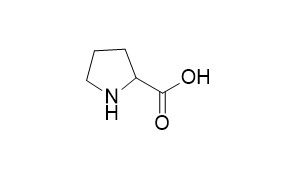DL-Proline
Reference standards.
Inquire / Order:
manager@chemfaces.com
Technical Inquiries:
service@chemfaces.com
Tel:
+86-27-84237783
Fax:
+86-27-84254680
Address:
1 Building, No. 83, CheCheng Rd., Wuhan Economic and Technological Development Zone, Wuhan, Hubei 430056, PRC
Providing storage is as stated on the product vial and the vial is kept tightly sealed, the product can be stored for up to
24 months(2-8C).
Wherever possible, you should prepare and use solutions on the same day. However, if you need to make up stock solutions in advance, we recommend that you store the solution as aliquots in tightly sealed vials at -20C. Generally, these will be useable for up to two weeks. Before use, and prior to opening the vial we recommend that you allow your product to equilibrate to room temperature for at least 1 hour.
Need more advice on solubility, usage and handling? Please email to: service@chemfaces.com
The packaging of the product may have turned upside down during transportation, resulting in the natural compounds adhering to the neck or cap of the vial. take the vial out of its packaging and gently shake to let the compounds fall to the bottom of the vial. for liquid products, centrifuge at 200-500 RPM to gather the liquid at the bottom of the vial. try to avoid loss or contamination during handling.
J Biochem Mol Toxicol.2025, 39(8):e70416.
Plants (Basel).2024, 13(23):3314.
Antioxidants (Basel).2021, 10(10):1638.
Horticulturae2021, 7(1),5.
Appl Microbiol Biotechnol.2018, 102(12):5105-5120
Oxid Med Cell Longev.2021, 2021:4883398.
J Food Composition and Analysis2022, 104417.
Pest Manag Sci.2023, 79(8):2675-2685.
Front Plant Sci.2022, 13:982771.
Molecules.2017, 22(3)
Related and Featured Products
Journal of Liquid Chromatography & Related Technologies, 2013, 36(17).
Thin-layer chromatographic evidence of proline peptidization in solution and its thin-layer chromatographic enantioseparation.[Reference:
WebLink]
Direct enantioseparation of underivatized amino acids dissolved in the aqueous and nonaqueous solvents by means of the chiral TLC is a difficult analytical task. Most often such enantioseparations are carried out for the derivatized amino acids, or by means of the ion-exchange chromatography or electrophoresis. The main reasons of the aforementioned difficulty seem an ability of the chiral low molecular weight carboxylic acids (amino acids included) to undergo spontaneous condensation and spontaneous chiral conversion, as confirmed, for example, by the results of our earlier studies.
METHODS AND RESULTS:
In this study, we provide an experimental evidence of rapid peptidization of L-proline and DL-Proline obtained by means of the two different TLC systems, additionally confirmed by LC/MS and 1H NMR spectroscopy. Additionally, a novel TLC system for the direct enantioseparation of DL-Proline is proposed, which considerably outperforms earlier elaborated systems.
CONCLUSIONS:
Finally, relevant practical conclusions are drawn.
Crystengcomm, 2012, 14.
Effect of enantiomeric ratio and preparation method on proline crystal form[Reference:
WebLink]
METHODS AND RESULTS:
Proline enantiomers were crystallized in a range of enantiomeric ratios and characterized by thermal methods, X-ray diffraction, and solid-state NMR spectroscopy to qualitatively and quantitatively characterize the resulting crystal forms.
When crystallized by solvent evaporation or in the absence of enantiomeric excess, the observed racemic cocrystal consisted of only the previously published form,DL-Proline (form I). However, lyophilization of solutions containing enantiomeric excess resulted in the presence of a new, thermodynamically stable polymorph of the racemic cocrystal,DL-Proline form II. Both the enantiomeric ratio and crystallization method influenced the polymorphism of the racemic cocrystal.
CONCLUSIONS:
Due to the prevalence of chiral molecules and cocrystals among pharmaceuticals, this work has implications for current polymorphic screening methods.



